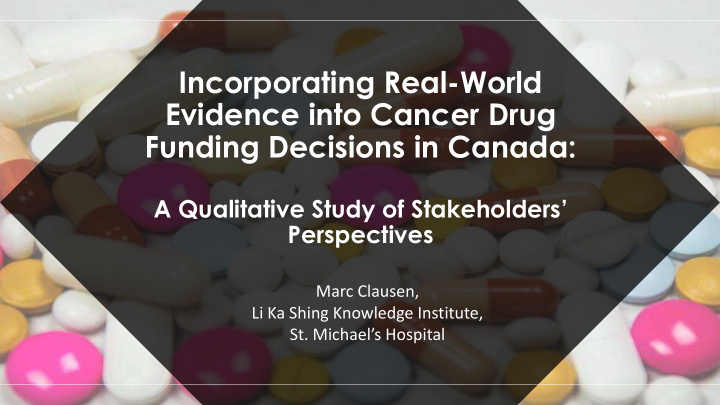



Incorporating Real-World Evidence into Cancer Drug Funding Decisions in Canada: A Qualitative Study of Stakeholders’ Perspectives Marc Clausen, Li Ka Shing Knowledge Institute, St . Michael’s Hospital
RESEARCH TEAM Project Lead: Yvonne Bombard, Li Ka Shing Knowledge Institute, St. Michael’s Hospital • Marc Clausen, Li Ka Shing Knowledge Institute, St. Michael’s Hospital • Chloe Mighton, Li Ka Shing Knowledge Institute, St. Michael’s Hospital • Ruhi Kiflen, Li Ka Shing Knowledge Institute, St. Michael’s Hospital • Wei Fang Dai, CancerCare Ontario • Rebecca Mercer, CancerCare Ontario • Jaclyn Beca, CancerCare Ontario • Wanrudee Isaranuwatchai, Li Ka Shing Knowledge Institute, St. Michael’s Hospital • Kelvin Chan, Sunnybrook Odette Cancer Centre The team has no conflicts of interest to disclose
Cancer Drug Funding and Real World Evidence (RWE) Rising Cost of Cancer Drugs RWE How? Limitations of Gaps in Cancer Clinical Trial Drug Funding Data Process
Objective: Collaboration to develop a framework for the generation and use of Real-World Evidence for cancer drug funding decisions in Canada Phase One: Understand Current State of RWE in Canada
AIMS AND METHODS Aim Methods Explore stakeholders’ views • Semi-structured interviews regarding the development and (in person / phone) implementation of a framework • Pan-Canadian and international to incorporate RWE in cancer sample of stakeholders drug funding decisions in Canada • Convenience / Snowball Sample • Thematic analysis
Results N=30 International Patient Industry Academic Decision Rep Makers April – December 2018 Atlantic, Central (minus Quebec), Prairies, West Coast Stakeholders: Provincial and federal decision- • makers Academics • Industry • Patient group representatives • n=3 n=4 n=4 n=5 n=14 International users • 4/23/2019 6
Results Current State Of Data Need for Building Collaboration Capacity Culture Shift 7
Theme 1: Culture Shift • Enthusiasm • Close RCT evidence gaps / shortcomings • Delisting, renegotiations, supporting current drug funding However … • RCTs gold standard “I guess it’s just easier with randomized controlled trials, because I think the approach and the accepted analytical methods are much better known. I think people are more comfortable with • RWE = lower quality evidence them. And there’s a lot more debate, and I guess uncertainty about what the best methods would be in real world evidence because there’s so many variables. I’m not sure that there’s one way. It • Conservative culture creates a situation where it’s, I guess easy to criticize any analysis that’s done. I would say, in general, they work very hard to make sure that it’s an appropriate analysis, but they could still be A shift in culture on the use of non RCT generated data: Accept quite subject to criticism” -#014 risks inherent to RWE 8
Theme 2: Current State of Data Current Data Insufficient for Decision-Making Collection: Incomplete (“patchy”) datasets • Varied data collection practices • Lacking key decision-making measures? • Access: limited / time and resource intensive / Privacy vs. access • “I also think that there’s still a scarcity of data, that we don’t have data for State of Data a Major Barrier everything yet. We have a lot of data, but it seems to be unorganized and lack of Too unreliable and too complex • consistency of how people are gathering data. So, until we really can get our data together, and that it’s shared, it’s consistent, it’s gathered in the same way, and it’s Desire for Systems Transformation: RWE catalyst for a coordinated data infrastructure in Canada pool- able, until that is done I think it can be challenging to really use the data” - #010 9
Theme 3: Building Capacity Investment in Building Capacity • Few with RWE experience in public setting • Requires time and cost intensive investment (staff, systems, etc). Who Pays? • Who leads? “ So it’s a kind of problematic issue right now to be pursuing real world evidence based agreements for too many products because they’re very A barrier to adoption, but also opportunity: Tangible complex and it takes a long time and it takes a lot of resources because objectives that will lead to successful implementation capacity is very stretched ” -#07 10
Theme 4: Need for Collaboration Increase Collaboration Among Stakeholders Systems currently operating in “silos” : • Clinicians, patients, industry, policy-makers • Leads to duplication, inefficiencies Public / Industry Relations: “If you're going to do these studies, there has to be a change in the attitudes • Hesitant between the players. Like, the payers, government, and cancer agencies, typically • Opportunity to improve relations don't have a really good relationship with industry … only if you have that kind of • Industry will need to have a role in RWE collaborative environment, would you actually be able to undertake some of these studies efficiently and effectively.” - #002 RWE an opportunity to evolve how stakeholders work together: revisit collaboration with industry? 11
Opportunities for Implementation Leverage Decision- Makers’ enthusiasm for RWE and desire for systems transformation Lack of understanding of how RWE is operationalized Address gaps in understanding how RWE works in application • Work done to address barriers to adoption Provide transparency on what has already been achieved • Clarify perceived barriers that will not actually impact adoption • 13
Recommend
More recommend